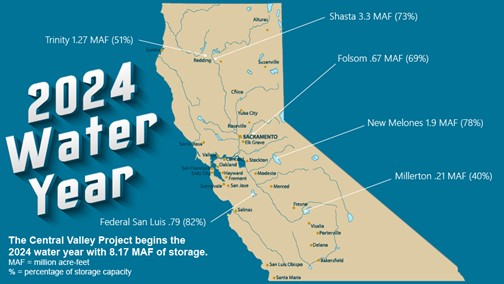Total reservoir storage of 8.17 million acre-feet more than double of last year
SACRAMENTO, Calif. – A record-setting winter in 2023 has left the Bureau of Reclamation’s Central Valley Project reservoirs in good shape as it begins the 2024 water year with 8.17 million acre-feet of water in storage.
“We could not have asked for better conditions in 2023 and the rain and snow were a welcome reprieve after the driest three-year stretch ever,” said Reclamation Regional Director Ernest Conant. “The ample precipitation California received has left our reservoirs well positioned as we transition to a new water year.”
California’s drought was effectively eliminated between December 2022 and March 2023 as a series of at least 12 strong and extreme atmospheric rivers hit the West Coast. The storms’ aftermath marked the first time since 2020 that none of California was in exceptional or extreme drought.
Early in 2023, so much water was in the system that Reclamation declared the availability of Section 215 water for those able to enter temporary water service contracts. (Section 215 refers to a provision in the Reclamation Reform Act of 1982 that defines temporary water supplies and allows non-storable water to be applied to lands otherwise ineligible to receive federal water).
Reclamation’s initial CVP allocation of 35% in February reflected the improved hydrologic conditions. By March, Shasta Reservoir increased to 81% of capacity, and San Luis Reservoir, the largest off-stream reservoir in the U.S., increased to 97%. In April, Reclamation increased all CVP water supply allocations to 100%.
Regional Director Conant added, “While we are pleased to start the 2024 water year with reserves, we know firsthand that California’s changing climate is unpredictable and dry years will undoubtedly reoccur. Reclamation will continue to manage water supplies accordingly and as always, encourage conservation and wise use of our water resources.”
The CVP’s major reservoirs are (from north to south) Trinity, Shasta, Folsom, New Melones, Millerton, and the federal share of San Luis Reservoir. The water year begins Oct. 1 each year and ends Sept. 30.


The CVP is the largest single source of irrigation water in California, typically supplying water to about 3 million acres of agricultural land in the San Joaquin and Sacramento valleys. The CVP also provides urban water for millions of people and industrial water, including that essential to the San Francisco Bay Area’s economy. Water from the CVP is also vital for the environment, wildlife and fishery restoration, including providing water to 19 refuges in the Central Valley, and hydroelectric power production.
For additional storage information, visit www.usbr.gov/mp/cvo; for additional information on the 2022 water year, visit www.usbr.gov/mp/drought.


